 BY JEFF DEENEY FOR THE NATION CeaseFire works through aggressive peer-led street outreach by ex-offenders with deep ties to the community, who gather intelligence on gangs in order to spot potential conflicts. Such conflicts are then mediated by the program’s famed violence “Interrupters.” At its peak, CeaseFire Chicago employed fifty outreach workers and fifty Interrupters, chosen from pools of candidates screened by professional and community panels to ensure they’d left the hustling life. Statisticians analyze the data gathered by outreach teams alongside data tracking violence collected by law enforcement, identifying up-to-the-moment crime hot spots, and focusing the program’s resources on those places where recent flare-ups of violence have potential to multiply through retaliation, breaking out and infecting whole neighborhoods.
BY JEFF DEENEY FOR THE NATION CeaseFire works through aggressive peer-led street outreach by ex-offenders with deep ties to the community, who gather intelligence on gangs in order to spot potential conflicts. Such conflicts are then mediated by the program’s famed violence “Interrupters.” At its peak, CeaseFire Chicago employed fifty outreach workers and fifty Interrupters, chosen from pools of candidates screened by professional and community panels to ensure they’d left the hustling life. Statisticians analyze the data gathered by outreach teams alongside data tracking violence collected by law enforcement, identifying up-to-the-moment crime hot spots, and focusing the program’s resources on those places where recent flare-ups of violence have potential to multiply through retaliation, breaking out and infecting whole neighborhoods.
Unlike harsh police crackdowns that can create an adversarial relationship with the community, CeaseFire’s first task is to establish its credibility as an ally in the fight against violent crime. It does this by relentlessly canvassing a given neighborhood, building relationships with corner drug dealers and truant youths, as well as the families, local leaders and faith groups who support its work. Outreach team members visit hospitals to counsel gunshot victims and go to funerals to stand alongside the friends of murdered street associates. They get access cops can’t get; kids involved with guns and drugs will talk openly and honestly with CeaseFire workers because of their shared history of hustling dope and packing straps. Not seen as snitches, CeaseFire outreach workers can get privileged details about grudges between gangs that could flare into open war. In addition to preventing this kind of violence, CeaseFire workers continue to engage with the youths involved to change the cultural norms that make retaliatory shootings seem like rational responses to perceived slights and petty disses.
The Interrupters captures how risky this kind of intensive field work can be; weapons sometimes come out while CeaseFire is on the scene and outreach workers have even taken bullets for the program. But the film also shows how the intensive mentoring provided by CeaseFire teaches young men and women to find constructive ways to resolve conflicts rather than reaching for a gun. The results are astonishing; over the course of three years CeaseFire entirely eradicated retaliatory homicides in four Chicago neighborhoods and nearly halved them in three others. Such results stand in sharp contrast to law enforcement crackdowns that can actually spread violence into previously uninfected communities, as gun-strapped hustlers “fall back,” fleeing cop-targeted hot spots and moving to less violent neighborhoods where they aren’t immediately recognized by police. “We’re like the iPod in a world of tapes or vinyl records,” Slutkin says, referring to cities stuck on older, law enforcement–driven approaches to violence. MORE

